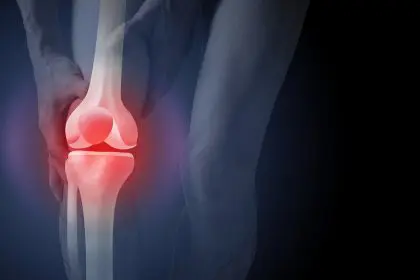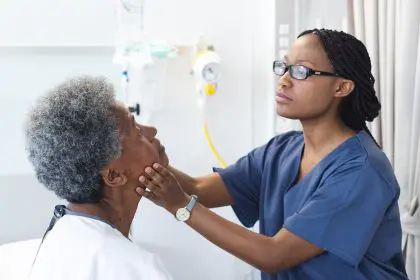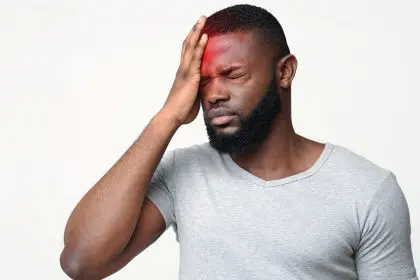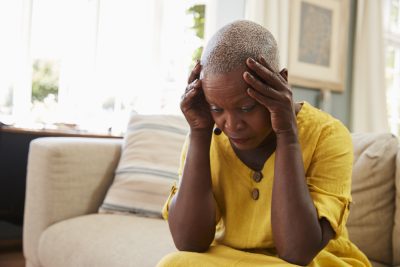Lymphoma, a cancer of the immune system, is silently ravaging the health of Black men across America. This insidious disease, which begins in the body’s lymphatic system, has become a growing concern in the medical community due to its disproportionate impact on Black male populations.
While cancer doesn’t discriminate, research reveals that Black men face unique risks, particularly when it comes to specific types of lymphoma. The consequences of late detection or inadequate treatment can be devastating, making awareness and early intervention crucial.
The most common culprit
Among the various forms of lymphoma, diffuse large B-cell lymphoma (DLBCL) emerges as the primary threat to Black men’s health. This aggressive subtype of non-Hodgkin lymphoma (NHL) accounts for about 30% of all NHL cases in the United States. For Black men, the prevalence and impact of DLBCL are particularly alarming.
DLBCL’s rapid growth and spread throughout the body make it a formidable opponent. Tragically, Black men often receive their diagnoses at more advanced stages compared to other racial groups. This delay can significantly worsen outcomes and increase the risk of complications.
The roots of disparity: Several factors contribute to this troubling trend. Limited access to quality healthcare, socioeconomic challenges, and a deep-seated mistrust of the medical system—born from historical inequities—all play a role in delayed diagnoses and treatment.
Recognizing the warning signs
Awareness is the first line of defense against lymphoma. Black men must familiarize themselves with the early warning signs, which can be subtle but crucial. Key symptoms to watch for include:
- Swollen lymph nodes, especially in the neck, armpits, or groin
- Unexplained weight loss
- Persistent fatigue
- Fever without apparent cause
- Night sweats
- Shortness of breath or a persistent cough
The importance of early action: Many dismiss these symptoms as minor health issues or postpone medical consultations due to various barriers. However, early diagnosis can dramatically improve outcomes, especially for aggressive lymphomas like DLBCL.
Diagnosis and treatment: Navigating the healthcare maze
When lymphoma is suspected, doctors employ various diagnostic tools, including blood tests, biopsies, and imaging scans such as PET or CT scans. For Black men, advocating for these diagnostic measures can be life-saving.
Treatment options for DLBCL have expanded in recent years. While chemotherapy, radiation therapy, and immunotherapy remain common approaches, targeted therapies and stem cell transplants offer new hope for patients with aggressive forms of lymphoma.
Obstacles to optimal care: Despite these advancements, Black men often face significant hurdles in receiving the best available treatments. Limited access to specialized cancer centers and disparities in healthcare delivery can result in suboptimal care. The emotional toll of a cancer diagnosis further complicates the journey, demanding resilience from patients and their loved ones.
Addressing healthcare disparities
The inequalities in lymphoma care for Black men are stark and undeniable. Studies consistently show that Black patients are less likely to receive timely diagnoses, participate in clinical trials, or access cutting-edge treatments compared to other racial groups. These disparities lead to poorer outcomes, higher mortality rates, and an increased emotional burden on Black men and their families.
A call for systemic change: Addressing these issues requires action on multiple fronts. From advocating for more equitable healthcare policies to increasing lymphoma awareness in Black communities, there’s an urgent need for comprehensive reform. Healthcare providers must also work to rebuild trust within the Black community, ensuring that more men receive the care they deserve.
Charting a path forward
Education and awareness are critical to improving outcomes for Black men facing lymphoma. Encouraging regular doctor visits, promoting symptom awareness, and empowering men to advocate for themselves within the healthcare system are essential steps.
The medical community must intensify research into the factors that make Black men more vulnerable to lymphoma and develop targeted strategies for prevention and treatment. Community organizations and health advocates can bridge gaps by hosting informational sessions, facilitating access to screening programs, and offering support to those affected by lymphoma.
Lymphoma, particularly DLBCL, poses a serious threat to the health of Black men. While significant challenges exist in early detection and treatment, increased awareness, advocacy, and equitable access to healthcare can help mitigate these risks. By working together, we can strive for a future where all Black men have the resources and support they need to combat lymphoma effectively and lead healthier, longer lives.
This story was created using AI technology.














